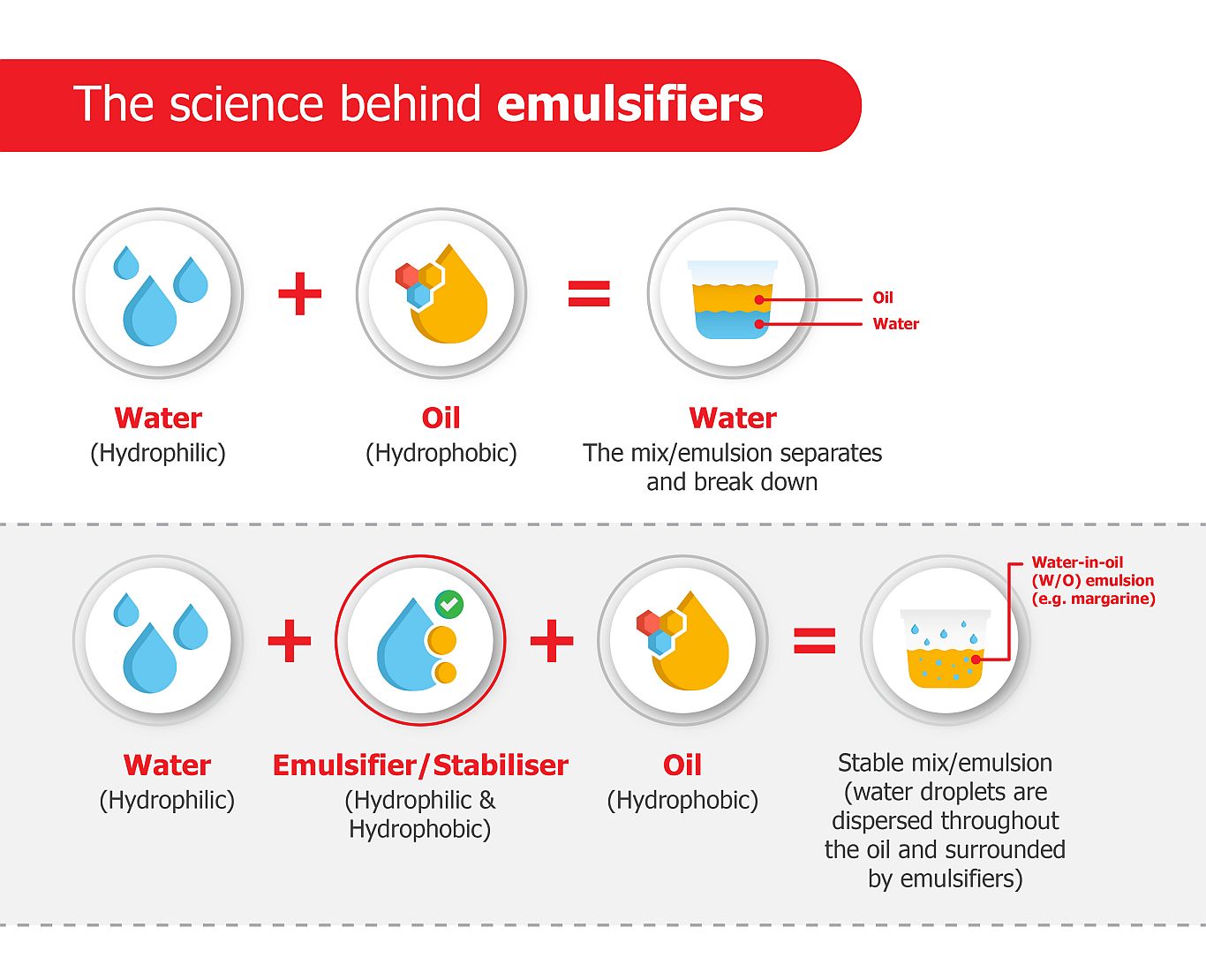How Emulsifier In Food Affects Mouthfeel and Flavor
Why It Is Required to Include an Emulsifier in Food for Optimum Preference and Quality
Emulsifiers play a crucial role in food production by guaranteeing the stable mixing of immiscible fluids, such as oil and water. They minimize interfacial stress, which protects against the splitting up of active ingredients and adds to a consistent appearance. This not just improves mouthfeel however additionally impacts flavor understanding. Understanding the requirement of emulsifiers discloses much deeper understandings into their function and relevance in cooking applications. What implications does this have for food advancement and consumer choices?
Understanding Emulsifiers: The Fundamentals
Emulsifiers play a necessary duty in food scientific research, acting as representatives that promote the mixing of two immiscible liquids, such as oil and water. These compounds have both hydrophilic (water-attracting) and hydrophobic (water-repelling) residential or commercial properties, which allow them to stabilize solutions. Typical emulsifiers consist of lecithin, discovered in egg yolks and soybeans, and mono- and diglycerides, stemmed from fats.
The Science Behind Emulsification
When two immiscible liquids are combined, the procedure of emulsification ends up being essential for attaining a secure blend. Emulsification involves distributing one liquid within an additional, normally oil in water or the other way around. This process occurs through mechanical agitation, which damages the larger droplets right into smaller sized ones, therefore increasing the surface. Without the visibility of emulsifiers, these droplets would certainly coalesce, leading to separation.
Emulsifiers are particles with hydrophilic (water-attracting) and hydrophobic (water-repelling) buildings. Their special structure enables them to lower the interfacial tension between both immiscible fluids, stabilizing the solution. This stabilization protects against separation and enhances the uniformity of texture and flavor. The interactions at the molecular degree are important for maintaining the stability of the emulsion, making sure that food products maintain their preferred consistency and taste. Understanding this science is significant for food researchers and manufacturers in developing top quality food products.
Types of Emulsifiers Utilized in Food
The kinds of emulsifiers made use of in food can be broadly categorized into natural and synthetic selections. Common food emulsifiers, such as lecithin and mono- and diglycerides, play a crucial function in boosting food security and appearance. Understanding these distinctions is vital for appreciating how emulsifiers add to the overall high quality of foodstuff.
All-natural vs. Synthetic Emulsifiers
While both all-natural and artificial emulsifiers serve the vital role of maintaining mixtures in foodstuff, their characteristics and beginnings differ markedly. Natural emulsifiers, originated from plant or animal resources, include lecithin, casein, and specific periodontals. They are typically perceived as much healthier options, interesting customers looking for clean-label items. In comparison, artificial emulsifiers, such as mono- and diglycerides, are chemically engineered and may supply improved security and functionality in a bigger series of applications. These synthetic alternatives can be extra economical and provide regular quality. They might evoke apprehension among health-conscious customers. Inevitably, the option in between natural and synthetic emulsifiers depends upon the desired qualities of the food product, including appearance, taste, and shelf-life security.
Usual Food Emulsifiers
Emulsifiers play a vital role in the food sector, ensuring the security and texture of various items. Common food emulsifiers consist of lecithin, mono- and diglycerides, and polysorbates. Emulsifier In Food. Lecithin, originated from resources like soybeans and egg yolks, is widely made use of in baked items and delicious chocolates. Mono- and diglycerides, frequently acquired from veggie oils, improve the creaminess of margarine and gelato. Polysorbates, artificial emulsifiers, are regularly located in salad dressings and sauces, promoting a smooth consistency. Other emulsifiers such as xanthan gum tissue and guar periodontal, both all-natural thickeners, likewise add to the preferred appearance in numerous food. Each emulsifier kind serves details functions, contributing to the overall high quality and appeal of food things

Function in Food Security
Food security is greatly influenced by the kinds of emulsifiers made use of, which assist avoid the splitting up of active ingredients in different formulations. Emulsifiers such as lecithin, mono- and diglycerides, and polysorbates play necessary roles in preserving the harmony of products like dressings, sauces, and gelato. Lecithin, stemmed from soy or egg yolk, is especially reliable because of its all-natural homes, while mono- and diglycerides improve structure and shelf life. Polysorbates, on the various other hand, improve the security of oil-in-water emulsions, making them excellent for baked products. The selection of emulsifier depends on the certain food application and wanted characteristics, ensuring that products stay stable, enticing, and of high quality throughout their intended shelf life.
How Emulsifiers Improve Appearance and Mouthfeel
Enhancing the sensory experience of food, emulsifiers play an essential duty in enhancing structure and mouthfeel. These substances promote the consistent distribution of ingredients, enabling a smoother and creamier consistency in products such as dressings, sauces, and gelato. By stabilizing blends of oil and water, emulsifiers stop separation, leading to a natural texture that boosts the total consuming experience.
Moreover, emulsifiers can customize the viscosity of food, adding to a preferable thickness or creaminess. This alteration of appearance can influence exactly how food feels in the mouth, impacting fulfillment and satisfaction. Additionally, by creating a stable emulsion, emulsifiers aid maintain the stability of the item, making certain that the intended mouthfeel is consistently provided gradually. Generally, the application of emulsifiers is important for achieving the appropriate structure and mouthfeel, inevitably raising the quality of foodstuff.
The Duty of Emulsifiers in Taste Improvement
Flavor enhancement in cooking applications often depends upon the reliable use emulsifiers. These compounds facilitate the blending of water and oil, permitting the even circulation of taste compounds within food items. By developing stable solutions, emulsifiers assist to envelop and launch volatile flavors, improving the overall sensory experience.
Furthermore, emulsifiers can improve the assumption of taste by affecting the mouthfeel and structure of dishes. A smoother, much more cohesive product can bring about an increased understanding of flavors, making them more obvious and delightful. Additionally, emulsifiers can shield sensitive tastes from destruction, guaranteeing that they stay undamaged throughout handling and storage.
Emulsifiers in Popular Food Products
Exactly how do emulsifiers add to the appearance and security of prominent food items? Emulsifiers play an important duty in various widely consumed products. In salad dressings, they ensure a smooth blend of oil and vinegar, preventing splitting up and boosting mouthfeel. In gelato, emulsifiers produce a velvety structure by supporting air bubbles, causing a abundant and indulgent product. Baked goods, such as bread and cakes, gain from emulsifiers by boosting quantity and crumb framework, resulting in a lighter and extra appealing appearance. Furthermore, mayo depends on emulsifiers to maintain its thick uniformity and avoid oil separation. Margarine and spreads also use emulsifiers to attain a spreadable texture while preserving stability. These examples show the considerable influence of emulsifiers on the quality and enjoyment of day-to-day foodstuff, underscoring their importance in contemporary food solution.
The Future of Emulsifiers in Food Development
The future of emulsifiers in food development is marked by significant improvements in modern technology, leading the way for brand-new formulas. Furthermore, the need for healthier emulsifier choices is climbing, prompting scientists to check out natural and plant-based options. Sustainable sourcing practices are additionally ending up being important, as customers increasingly focus on environmental obligation in their food options.
Innovations in Emulsifier Technology
As scientists proceed to check out the molecular intricacies of emulsifiers, considerable innovations are arising that pledge to revolutionize food development. Recent growths concentrate on creating more functional and effective emulsifiers that boost texture, stability, and taste in numerous foodstuff. Innovations in biopolymer-based emulsifiers are gaining grip, offering improved sustainability and efficiency over standard options. Additionally, developments in nanotechnology are allowing the design of emulsifiers at the molecular degree, which can bring about finer solutions and improved sensory experiences. These technical advancements are not only improving product high quality however likewise increasing the series of applications for emulsifiers in the food industry. As these technologies unfold, they are anticipated to redefine cooking possibilities and customer preferences in the future.
Healthier Emulsifier Alternatives
While standard emulsifiers have actually played a necessary function in food manufacturing, there is an expanding need for healthier options that straighten with customer preferences for natural active ingredients and article source clean tags. Developments in plant-based emulsifiers, such as those view originated from soy, sunflower, and flaxseed, have actually gained popularity because of their viewed wellness advantages. These options often contain less ingredients and provide functionality comparable to synthetic emulsifiers. Additionally, components like aquafaba, the fluid from prepared chickpeas, have actually become flexible emulsifying representatives, interesting vegan and health-conscious consumers. Emulsifier In Food. The shift in the direction of these healthier emulsifiers not just improves the appeal of foodstuff yet likewise supports the pattern of transparency in active ingredient sourcing, ultimately promoting customer trust and fulfillment

Lasting Sourcing Practices
Sustainable sourcing practices are ending up being increasingly crucial in the growth of emulsifiers, mirroring a more comprehensive dedication to environmental duty within the food sector. Suppliers are currently focusing on the usage of renewable energies, such as plant-based active ingredients, which lessens the carbon impact associated with traditional emulsifiers. This change not only sustains biodiversity but likewise promotes ethical farming methods that benefit local areas. In addition, developments in modern technology allow the extraction and processing of emulsifiers with minimized ecological impact. By embracing sustainable sourcing, business boost their brand name photo while meeting customer need for openness and eco-friendliness. As the food industry remains to progress, the assimilation of lasting emulsifiers will certainly play a crucial duty fit future developments, ensuring an equilibrium between top quality and environmental stewardship.
Often Asked Inquiries
Are Emulsifiers Safe for People With Food Allergies?

Can Emulsifiers Impact the Nutritional Worth of Food?
Emulsifiers can affect the nutritional value of food by boosting nutrition absorption or possibly modifying the bioavailability of certain substances. Their impacts vary widely depending on the kind of emulsifier and the general food solution.
Exactly How Do Emulsifiers Influence Service Life of Products?
Emulsifiers boost the shelf life of products by maintaining mixtures, avoiding separation, and minimizing wasting. This security helps keep texture and taste over time, ultimately making sure food remains secure and attractive for longer periods.
What Prevail Natural Emulsifiers Located in Home Kitchens?
Common natural emulsifiers discovered in home kitchens include egg yolks, mustard, soy, and honey lecithin. These ingredients aid maintain mixtures by lowering surface tension in between oil and water, enhancing texture and uniformity in different dishes.
Exist Any Interest In Synthetic Emulsifiers in Food?
Problems concerning synthetic emulsifiers in food consist of possible digestive problems, inflammatory actions, and links to obesity. Some researches recommend these ingredients might disrupt digestive tract microbiota, questioning about their long-lasting effects try this website on wellness and health.
Usual food emulsifiers, such as lecithin and mono- and diglycerides, play a crucial function in boosting food stability and structure. Emulsifiers play a necessary role in the food sector, making certain the stability and texture of different products - Emulsifier In Food. Various other emulsifiers such as xanthan periodontal and guar gum, both natural thickeners, additionally add to the desired appearance in numerous food products. Recent developments focus on creating a lot more functional and efficient emulsifiers that boost texture, security, and taste in various food items. Emulsifiers can position threats for individuals with food allergic reactions, as some emulsifiers are obtained from irritants like soy or eggs